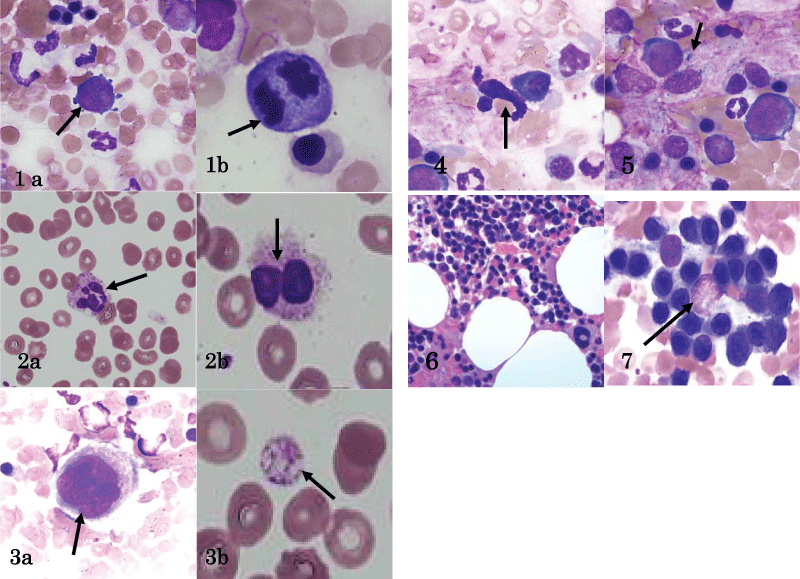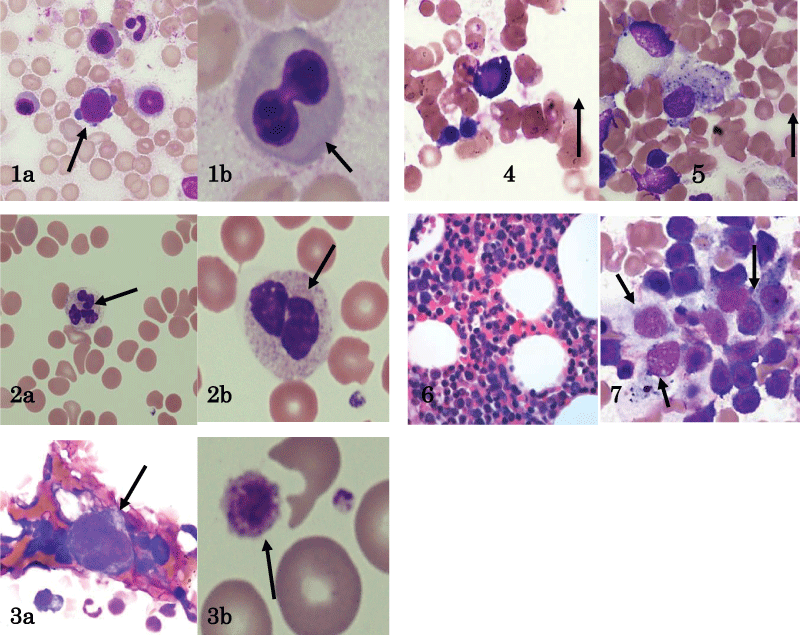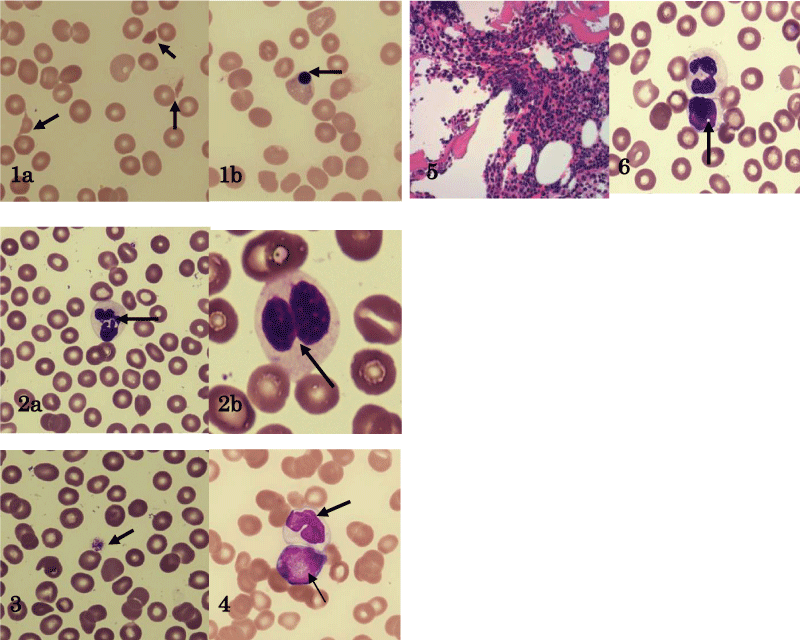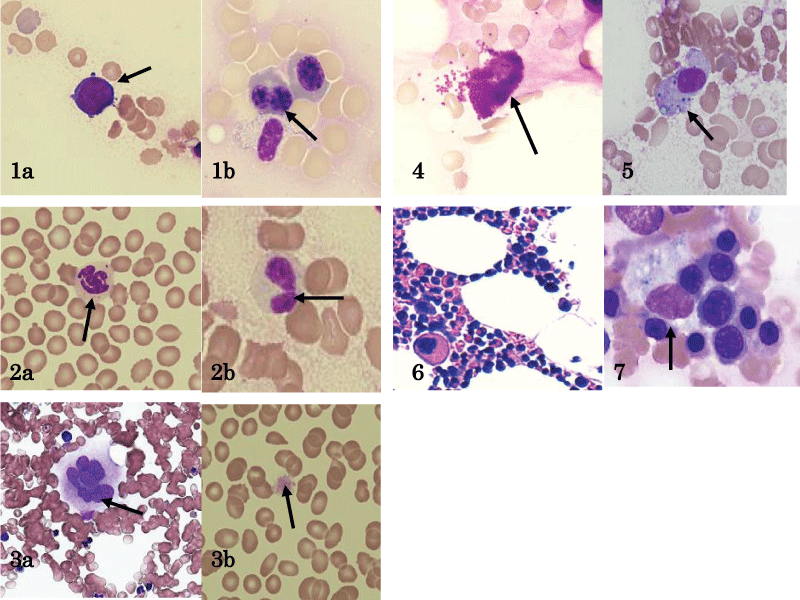International Journal of Immunology and Immunotherapy
Hemolysis of Some Elderly MDS Cases Might be Related to Prolonged Parvovirus B19 Infection
Nagahito Saito1*, Kiminari Ito1, Katsuhiro Higashiura1, Rinji Murakami1, Naotaka Miyoshi1, Toshiaki Nakagawa1, Maneo Yamamoto1, Chiko Ueno1, Kenta Honma1, Makio Ishikawa1, Kazunori Ehata2, Tomoyuki Yanami2, Katsumi Katagiri2 and Hong Kean Ooi3
1Internal Medicine, Nemuro City Hospital, Japan
2Medical Laboratory, Nemuro City Hospital, Japan
3Veterinary Medicine, Azabu University, Japan
*Corresponding author:
Nagahito Saito, Internal Medicine, Nemuro City Hospital 1-2, Ariiso-cho, Nemuro, Hokkaido, 087-8686, Japan, E-mail: nagahitosaito@k7.dion.ne.jp
Int J Immunol Immunother, IJII-2-012, (Volume 2, Issue 2), Case Report; ISSN: 2378-3672
Received: June 23, 2015 | Accepted: July 24, 2015 | Published: July 27, 2015
Citation: Saito N, Ito K, Higashiura K, Murakami R, Miyoshi N, et al. (2015) Hemolysis of Some Elderly MDS Cases Might be Related to Prolonged Parvovirus B19 Infection. Int J Immunol Immunother 2:012. 10.23937/2378-3672/1410012
Copyright: © 2015 Saito N, et al. This is an open-access article distributed under the terms of the Creative Commons Attribution License, which permits unrestricted use, distribution, and reproduction in any medium, provided the original author and source are credited.
Abstract
Myelodysplastic syndrome (MDS) is a hematological disorder due to abnormal maturation and differentiation of stem cells. It is clinically manifested as cytopenia and commonly seen in elderly persons. Some MDS cases are known to show longitudinal hemolysis, which is attributed to various factors. Human parvovirus B19 (B19V) had been found in blood for transfusion and is also capable of infecting immature erythroid cells. In our study, we made a thorough review of six elderly MDS cases with slight immunological abnormality and longitudinal hemolysis to elucidate their association with B19V infection. Five of the six cases had received blood transfusion prior to coming to the hematological section of our hospital. All the 6 cases were positive for anti-B19V IgG antibody in their sera. In the bone marrow of all the cases, macrophages were observed to be directly in contact with the erythroid islands showing hypocellular marrow by biopsy. Based on the data of these cases, we proposed that hemolysis in elderly MDS patient with immunological abnormality might be related to B19V infection.
Keywords
Human parvovirus B19, Hemolysis, Myelodysplastic syndrome, Immunology, Erythroid island, Macrophage
Introduction
Myelodysplastic syndrome (MDS) is a hematological disorder due to abnormal regulation of the survival and differentiation programs that affect the proliferation, apoptosis and differentiation of stem cell. This disease shows many clinical symptoms and is generally being diagnosed in elderly persons [1]. These abnormalities of stem cell cause hemolysis en route in the red blood cell (RBC) maturation. An MDS patient is usually a compromised host because of high age, low nutrition and abnormality in the immune blood cells [2]. Therefore, in this disease, hemolysis is frequent, as exacerbated by malnutrition and/or inflammation.
Parvovirus B19 (B19V) is a human virus belonging to the genus, Erythrovirus, which attaches to its receptor on the surface of immature erythrocytes [3]. Clinical manifestation of B19V infection depends on the abnormality of immunological and hematological status. There is a detailed report on this subject in patients after organ transplantation [4]. The most common B19V manifestation is a temporal and benign disease with what looked like a slapped cheek in young children or with general arthritis in adult [5]. B19V has a propensity for infecting erythroid immature cells leading to severe anemia which sometimes resulted in aplastic crisis at acute phase [6]. Some studies suggested that the inflammation caused by this virus may persist for a long period of time under a continued state of immuno-abnormality to produce auto-antibodies such as rheumatoid arthritis or lymphoma [7,8]. Among the immuno-abnormal persons, B19V infection can persist causing chronic anemia [9]. To date, the question remains as to what kind of clinical features that persisting inflammation associated with B19V might lead to, via infected immature erythrocytes in slightly immuno-abnormal person with hematological disorder such as MDS.
In this study, we examined in detail, 6 elderly MDS patients with anti-B19V IgG antibody, mild level of hemolysis and slight immunological abnormalities to elucidate their clinical relationship with B19V infection.
Results
Case study
Overall picture of the cases: Six elderly persons (70 to 87 year-old) with several symptoms including anemia were sent to our hematological section of our hospital. Bone marrow (BM) puncture and biopsy were performed on all the patients. Morphological abnormalities of the three lineages of blood cells were examined for immature erythrocytes with multiple nuclei, proerythroblasts, neutrophils with few granules and/or over-lobulated nuclei, neutrophils showing pseudo-Pelger-Huët nuclei, large platelets over 5μm in diameter, micro-megakaryocytes and reticulum cells possessing iron particles in their cytoplasm [10]. Therefore, each of the cases was diagnosed as an MDS based on the various results, including the general examination of the peripheral blood [1]. However, these cases were different from the classic MDS as discussed by the FAB or WHO classification and other reports [11-13], because many immature erythrocytes aggregated together to form islands, and reticulum cells often adhere to such erythroid islands in BM samples except for a dry-tapped case (case 5). Several degrees of reticulocytosis were also observed during each examination. The biopsied specimens showed hypocellular marrows and several kinds of blood cells were observed without elevated number of immature cells. All cases were positive for anti-B19V IgG antibody in sera on admission in our hematological section (Figure 1a, Table 1).
Case 1
A 77-year-old female patient with agnogenic hypothyroidism was admitted to our hospital due to acute myocardial infarction. During hospitalization, she suddenly spitted up blood caused by gastric ulcer and had to be given red blood cell (RBC) transfusion. On the 14th day after blood transfusion, she became feverish with hematouria and was treated with antibiotics for an acute pyelonephritis. Three days later, LDH and indirect bilirubin were suddenly elevated and hemoglobin (Hb) was decreased 2g/dl in a day. No blood was detected in stool nor urine. CD59 on white blood cell (WBC) was not decreased at all. Morphological abnormalities in the three lineages were observed in peripheral and BM blood smears, and she was diagnosed as an MDS having hemolysis after BM examination. Indirect-Coombs test and anti-nuclear antibody (ANA) were positive. (Figure 1a, Table 1)

.
Figure 1a (Case 1): 1a, Proerythroblast (arrow), 1b, Erythroblast with plural nuclei (arrow), 2a, Neutrophil with hypersegmented nucleus (arrow), 2b,
Neutrophil with pseudo-Pelger-Huët like nucleus (arrow), 3a, Micro-megakaryocyte (Platelet, arrow) , 3b, Large platelet (arrow), 4, Mast cell (arrow), 5,
Reticulum cell with iron (arrow), 6, Broad range of blood cells (biopsy specimen), 7, Reticulum cell (arrow) directly contacting with an island by erythroblasts
View Figure 1a
![]()
Table 1: Picture of the cases
View Table 1
Case 2
A 70-year-old male had fallen down in his house because of the low level of Hb (6.9g/dl). He was sent to a hospital and given RBC transfusion. However, he was transferred to our hospital six months later as his anemia progressed rapidly. His wife said that his cheek color became red just like an apple after the first blood transfusion in the previous hospital. Although CD59 on WBC was within normal limit, LDH was slightly elevated and reticulocytosis was accompanied by unmeasurable hypometria of haptoglobin. Therefore, he was diagnosed as an MDS having hemolysis because morphological abnormalities were observed in the three lineages after examination of BM blood cells. He has complained of uncomfortable feeling such as pharyngitis and rhinitis during warm days in the change of the seasons since he was young. Soluble IL-2 receptor and β2-microglobrin in serum were elevated without positivity of ANA. (Figure 1b, Table 1)

.
Figure 1b (Case 2): 1a, Proerythroblast (arrow), 1b, Erythroblast with plural nuclei (arrow), 2a, Neutrophil with hypersegmented nucleus (arrow), 2b,
Neutrophil with pseudo-Pelger-Huët like nucleus (arrow), 3a, Micro-megakaryocyte (arrow), 3b, Large platelet (arrow), 4, Mast cell (arrow), 5, Reticulum cell
with iron (arrow), 6, Broad range of blood cells (biopsy specimen), 7, Reticulum cell directly contacting with an island by erythroblasts (arrow)
View Figure 1b
Case 3
A 71-year-old woman was operated for brain hemorrhage by a brain surgeon. She was sent to our hospital because her anemia persisted despite being given both RBC transfusion and injected iron. Hemoglobin was 7.5g/dl in the serum but no blood was detected in her stool or urine. LDH and reticulocytes were elevated. Haptoglobin was at the lower level, and direct-Coombs test was also positive. Almost all immature RBCs were sideroblasts on BM blood smears. Therefore, she was diagnosed as sideroblastic anemia with slight hemolysis. Morphological abnormalities were also observed in other two blood cell lineages. When she took some health food bought through television advertisement several years ago, she had a nettle rash. Soluble IL-2 receptor and β2-microglobrin in serum were elevated but negative for ANA on admission into our hospital. Direct-Coombs test was also positive. (Figure 1c, Table 1)

.
Figure 1c (Case 3): 1a, Proerythroblast (arrow), 1b, Erythroblast with nuclear division (arrow), 2a, Neutrophil with hypersegmented nucleus (arrow), 2b,
Neutrophil with pseudo-Pelger-Huët like nucleus (arrow), 3a, Micro-megakaryocyte (arrow), 3b, Large platelet (arrow), 4, Mast cell (arrow), 5, Reticulum cell
with iron (arrows), 6, Broad range of blood cells (biopsy specimen), 7, Reticulum cells directly contacting with an island by erythroblasts (arrows)
View Figure 1c
Case 4
A 79-year-old woman has been followed in some hospitals since she was diagnosed as having Gilbert disease more than 30 years ago because of the high level of indirect bilirubin. She had been given RBC transfusions in a hospital for anemia since then. She happened to visit to our hospital with urinary inflammation. At hospitalization, her thyroid hormone level was low despite without showing any sign of malnutrition. Although she recovered using antibiotics, both elevated indirect bilirubin and anemia coupled with severe reticulocytosis were observed. Liver dysfunction and bleedings in digestive tract were not observed at all. She was diagnosed as an MDS with hemolysis after a BM examination was performed. Direct-Coombs test was positive. Soluble IL-2 receptor and β2-2microglobin in serum were elevated without ANA being positive. (Figure 1d, Table 1)

.
Figure 1d (Case 4): 1a, Proerythroblast (arrow), 1b, Erythroblast with nuclear division (arrow), 2a, Neutrophil with hypersegmented nucleus (arrow), 2b,
Neutrophil with pseudo-Pelger-Huët like nucleus (arrow), 3a, Micro-megakaryocyte (arrow), 3b, Large platelet (arrow), 4, Mast cell (arrow), 5, Reticulum cell
with iron (arrow), 6, Broad range of blood cells (biopsy specimen), 7, Reticulum cell directly contacting with an island by erythroblasts (arrows)
View Figure 1d
Case 5
A 79-year-old male was referred to our hospital because of thrombocytopenia. Hb was 12g/dl with the elevated LDH and reticulocytes. Serum haptoglobin was at the lower level. Many disfigured RBCs and few immature RBCs were observed in the peripheral blood smears. BM aspirations were performed 4 times on different bones but failed to obtain any blood cells. A BM biopsy showed hypocellular marrow without elevated number of immature cells. Therefore, he was diagnosed as having Refractory cytopenia with accompanying hemolysis. Soluble IL-2 receptor and β2-microglobin in serum were elevated without ANA being positive. Before hospitalization, he had experienced skin rash by antibiotics in another hospital several years ago. While he was being followed for three years, he happened to feel palpitation and then visited our hospital. His peripheral blood smear showed approximately 20% of myeloblastic cells. Therefore, he was diagnosed as having acute myeloid leukemia via MDS and immediately underwent chemotherapies. Unfortunately, his disease did not respond to the treatments and it was decided that only RBC and platelet transfusions were selected for his remaining period. Half a year later, he died due to sepsis. (Figure 1e, Table 1)

.
Figure 1e (Case 5): 1a, Several formed RBC containing offcuts (arrows), 1b, Erythroblast observed on peripheral blood smear (arrow), 2a, Neutrophil with
hypersegmented nucleus (arrow), 2b, Neutrophil with pseudo-Pelger-Huët like nucleus (arrow), 3, Slightly large platelet (arrow), 4, Neutrophil with little
granules (arrow) and blastic cell (narrow arrow), 5, Broad range of blood cells (biopsy specimen), 6, Lymphoid cell with a small vacuolated nucleus (arrow)
View Figure 1e
Case 6
An 87-year-old woman with asthma, anemia and thrombo- cytopenia has been followed in some other hospitals several decades ago. She was sent our hospital because of sudden subcutaneous bleeding after orally taking ticlopidine hydrochloride. Platelet count was 1.7×104 /μl on admission at our hospital. Since she was diagnosed as having drug-induced thrombocytopenia, prednisolone was given to restore her platelets until over 10×104/μl. Fragments of RBC were frequently observed on the blood smear with elevated LDH, BUN, reticulocytes and ANA. BM specimen was fatty with morphological abnormalities in three lineages. Therefore, she was diagnosed as Refractory cytopenia accompanied by hemolysis and immunological abnormality. Soluble IL-2 receptor in serum was elevated. (Figure 1f, Table 1)

.
Figure 1f (Case 6): 1a, Proerythroblast (arrow), 1b, Erythroblast with plural nuclei (arrow), 2a, Neutrophil with hypersegmented nucleus (arrow), 2b,
Neutrophil with pseudo-Pelger-Huët like nucleus (arrow), 3a, Micro-megakaryocyte (arrow), 3b, Large platelet (arrow), 4, Mast cell (arrow), 5, Reticulum cell
with iron (arrow), 6, Broad range of blood cells (biopsy specimen), 7, Reticulum cell directly contacting with an island by erythroblasts (arrow)
View Figure 1f
Discussion
Though the clinical symptoms were varied, all the elderly cases in our study were diagnosed as MDSs. This is because their blood cells of the three lineages showed morphological abnormalities and their macrophage cytoplasm contains ingot irons, in addition to the general abnormal picture of their peripheral blood examination. Frequent presence of mast cells in BM blood smear also supported the diagnosis of MDS [10]. Generally, MDS in elderly person tends to manifest refractory cytopenia and hypo-hematopoiesis of erythrocytic precursor cells in bone marrow [1]. However, in our cases, we observed both the islands of immature erythroid cells in BM blood smear and reticulocytosis in peripheral blood. These observations were different from the archetypal elderly MDSs. These phenomena indicate positive hematopoiesis among the cells of erythroid lineage. Furthermore, macrophages were observed to be interposed among the erythroid cell's aggregates. This picture suggests hemolysis via the activation of macrophages in BM [14]. Although the significance of macrophage being directly in contacted to erythroid island is still obscure, such phenomenon has not been reported at all in typical MDSs among the elderly.
Hemolysis might generally be observed for cells of erythroid lineage in severely infected or malnourished elderly persons, especially in MDS. However, in our cases, the situation is associated with infection and insufficient nourishment was not observed as shown in table 1. All our cases showed hypo-cellular marrows expressing hypo-erythropoiesis in the BM biopsied specimens. Phagocytosis by macrophages of erythroid islands would point to the activation of such cells in the reticulo-endothelial system. Fragmented erythrocytes observed in peripheral blood smear also indicated the activation of reticulo-endothelial system. On the other hand, the macrophages that were in contact with the islands of immature erythroid cells were thought to be related to the proliferation and maturation of the precursor cells [15]. Intracytoplasmic-iron demonstrated the viability of macrophage in heme recycling system [16] and can induce immunological abnormality in the host, which can lead to infection [17] as the macrophages and erythroid cells making physical contact can exert influences on each other [18].
Degraded immunoglobulin and/or auto-antibodies in serum has been observed in some MDS patients [10,19]. Immunoglobulin was found to be diminished in five of our six cases, indicating the occurrence of immunological abnormality. Infection by B19V has been reported to cause the positivity of ANA [20]. However, in our study, only three out of 6 cases were positive for ANA. The remaining three other cases showed abnormalities of soluble-IL2 receptor, β2-microglobulin, immunoglobulin or Coombs-test. From our previous reports [10,19], immunological abnormalities such as positive ANA were not the result of past infection by B19V but might be the hallmarks of compromised host such as MDS. Each of our cases showed clinical symptoms of immunological abnormality at the time of admission. They might be episodes of decreased thyroid hormone (case 1), constant uncomfortable feeling around pharynx and in nasal cavity occurring annually (case 2), allergic reaction to health foods bought through television advertising program (case 3), dysfunction of thyroid gland without malnutrition (case 4), skin allergy to antibiotics (case 5) and asthma attack (case 6). Thus, our 6 patients were thought to possess some clinical form of immune-abnormality by nature. It is considered that B19V infection in immune-abnormal MDS persons will lead to the persistent infection state.
It is well-known that B19V infects erythroid immature cells [21] and the patient will exhibit decreased hematopoiesis of erythroid cells [22]. Generally, in blood smears of MDS patients biopsy showing hypocellular marrow, we could not see erythroid islands or the surrounding of such islands by macrophages because such islands indicate aggressive hematopoiesis of erythroid cells in the bone marrow. In addition to erythroid cells, B19V can also infect several other hematological cells, brain cells, skin, liver and spleen, which might lead to viral persistence in many organs [23-25]. There is a possibility that B19V might activate the macrophage to attach to the receptors on the erythroid cell surface, leading to the phenomenon of the macrophages directly adhering onto the erythroid islands [26]. Although B19V infection is a temporal disease in children [5], some persistent cases of B19V infection showed dysfunctional hematopoiesis [27], even in infected children [28]. B19V DNA has been detected in several organs for a long period of time, showing lifelong persistence [25], even in individuals with normal immunological status [29]. Since B19V can also infect granulocytic [30] or megakaryocytic cells [23], dysfunctional hematopoiesis will be elicited not only in cells of erythrocytic lineage but also in those of granulocytic or megakaryocytic lineages.
B19V can be also transmitted by blood transfusion [8,31]. In our case 1, the patient manifested acute nephritis within a few weeks after blood transfusion, pointing to a similar situation in earlier report [32]. Facial malar flush has been reported in acute infection by B19V in childhood [33]. In our case 2, his wife said that he showed malar flush on his face like red apples after blood transfusion. The episodes of case 1 and 2 might indicate the transmission of B19V through blood transfusion. Five out of our 6 cases had received blood transfusion previously before they were admitted to the hematological section in our hospital. However, it is obscurity whether the presence of their anti-B19V antibody was related to blood transfusion or not.
More than 50% of middle-aged or older adults were possibly infected with B19V in Japan [20]. The trigger for cell-to cell contact between macrophage and erythroid island is still not clear. After reviewing our 6 MDS cases, we postulated that prolonged infection by B19V in erythroid cells and/or macrophages in elderly MDS patients accompanied by slight immuno- abnormality could lead to various degrees of hemolysis due to compromised hematopoietic capability in the MDS bone marrows. At any rate, much more studies containing in vitro experiments should be needed for the clarification of relationship between B19V infection and hemolysis in elderly MDS patients.
In conclusion, we proposed that abnormal hematopoiesis and hemolysis in an MDS patient accompanied with immunological abnormality may be related to B19V infection.
References
-
Nimer SD (2008) Myelodysplastic syndromes. Blood 111: 4841-4851.
-
Aul C, Bowen DT, Yoshida Y (1998) Pathogenesis, etiology and epidemiology of myelodysplastic syndromes. Haematologica 83: 71-86.
-
Brown KE, Anderson SM, Young NS (1993) Erythrocyte P antigen: cellular receptor for B19 parvovirus. Science 262: 114-117.
-
Eid AJ, Brown RA, Patel R, Razonable RR (2006) Parvovirus B19 infection after transplantation: a review of 98 cases. Clin Infect Dis 43: 40-48.
-
Young NS, Brown KE (2004) Parvovirus B19. N Engl J Med 350: 586-597.
-
Servant-Delmas A, Lefrère JJ, Morinet F, Pillet S (2010) Advances in human B19 erythrovirus biology. J Virol 84: 9658-9665.
-
Crowson AN, Magro CM, Dawood MR (2000) A causal role for parvovirus B19 infection in adult dermatomyositis and other autoimmune syndromes. J Cutan Pathol 27: 505-515.
-
Norja P, Lassila R, Makris M (2012) Parvovirus transmission by blood products - a cause for concern? Br J Haematol 159: 385-393.
-
Coulombel L, Morinet F, Mielot F, Tchernia G, Knisely AS, et al. (1989) Parvovirus Infection, Leukemia, and Immunodeficiency. Lancet 333: 101-102.
-
Saito N, Higashiura K, Homma K, Kurosawa S, Ehata K, et al. (2012) T-cell prolymphocytic leukemia accompanied by plural M-proteins with myelodysplastic syndrome in a nonagenarian. J Clin Case Report 2: 131-133.
-
Bennett JM, Catovsky D, Daniel MT, Flandrin G, Galton DA, et al. (1982) Proposals for the classification of the myelodysplastic syndromes. Br J Haematol 51: 189-199.
-
WHO Classification of Tumours (2008) Tumours of Haematopoietic and Lymphoid Tissues. Swerdlow SH, Campo E, Harris NL, Laffe ES, Pileri SA (eds) 4th edn, Lyon, IARC.
-
Killick SB, Carter C, Culligan D, Dalley C, Das-Gupta E, et al. (2014) Guidelines for the diagnosis and management of adult myelodysplastic syndromes. Br J Haematol 164: 503-525.
-
Nagata S, Hanayama R, Kawane K (2010) Autoimmunity and the clearance of dead cells. Cell 140: 619-630.
-
Haldar M, Kohyama M, So AY, Kc W, Wu X, et al. (2014) Heme-mediated SPI-C induction promotes monocyte differentiation into iron-recycling macrophages. Cell 156: 1223-1234.
-
Kovtunovych G, Eckhaus MA, Ghosh MC, Ollivierre-Wilson H, Rouault TA (2010) Dysfunction of the heme recycling system in heme oxygenase 1-deficient mice: effects on macrophage viability and tissue iron distribution. Blood 116: 6054-6062.
-
Cambos M, Scorza T (2011) Robust erythrophagocytosis leads to macrophage apoptosis via a hemin-mediated redox imbalance: role in hemolytic disorders. J Leukoc Biol 89: 159-171.
-
Korolnek T, Hamza I (2015) Macrophages and iron trafficking at the birth and death of red cells. Blood 125: 2893-2897.
-
Saito N, Higashiura K, Ehata K, Kurosawa S, Honma K, et al. (2011) Myelodysplastic syndrome of del 20q with plasma cell dysplasia. J Clin Exp Hematop 51: 141-145.
-
Kumano K (2008) [Various clinical symptoms in human parvovirus B19 infection]. Nihon Rinsho Meneki Gakkai Kaishi 31: 448-453.
-
Takahashi T, Ozawa K, Takahashi K, Asano S, Takaku F (1990) Susceptibility of human erythropoietic cells to B19 parvovirus in vitro increases with differentiation. Blood 75: 603-610.
-
Kurtzman G, Frickhofen N, Kimball J, Jenkins DW, Nienhuis AW, et al. (1989) Pure red-cell aplasia of 10 years' duration due to persistent parvovirus B19 infection and its cure with immunoglobulin therapy. N Engl J Med 321: 519-523.
-
Brown KE, Anderson SM, Young NS (1993) Erythrocyte P antigen: cellular receptor for B19 parvovirus. Science 262: 114-117.
-
Millá F, Feliu E, Ribera JM, Juncà J, Flores A, et al. (1993) Electron microscopic identification of parvovirus virions in erythroid and granulocytic-line cells in a patient with human parvovirus B19 induced pancytopenia. Leuk Lymphoma 10: 483-487.
-
Norja P, Hokynar K, Aaltonen LM, Chen R, Ranki A, et al. (2006) Bioportfolio: lifelong persistence of variant and prototypic erythrovirus DNA genomes in human tissue. Proc Natl Acad Sci U S A 103: 7450-7453.
-
Munakata Y, Kato I, Saito T, Kodera T, Ishii KK, et al. (2006) Human parvovirus B19 infection of monocytic cell line U937 and antibody-dependent enhancement. Virology 345: 251-257.
-
Kurtzman GJ, Ozawa K, Cohen B, Hanson G, Oseas R, et al. (1987) Chronic bone marrow failure due to persistent B19 parvovirus infection. N Engl J Med 317: 287-294.
-
Murray JC, Kelley PK, Hogrefe WR, McClain KL (1994) Childhood idiopathic thrombocytopenic purpura: association with human parvovirus B19 infection. Am J Pediatr Hematol Oncol 16: 314-319.
-
Sasaki T, Murai C, Muryoi T, Takahashi Y, Munakata Y, et al. (1995) Persistent infection of human parvovirus B19 in a normal subject. Lancet 346: 851.
-
Kurtzman GJ, Gascon P, Caras M, Cohen B, Young NS (1988) B19 parvovirus replicates in circulating cells of acutely infected patients. Blood 71: 1448-1454.
-
Cohen BJ, Beard S, Knowles WA, Ellis JS, Joske D, et al. (1997) Chronic anemia due to parvovirus B19 infection in a bone marrow transplant patient after platelet transfusion. Transfusion 37: 947-952.
-
Ieiri N, Hotta O, Taguma Y (2005) Characteristics of acute glomerulonephritis associated with human parvovirus B19 infection. Clin Nephrol 64: 249-257.
-
Yabe T, Mitsuishi T, Kawana S (2004) Clinical examination of 67 patients with human parvovirus (HPV) B19 infection. Jpn J Dermatol 114: 1271-1275.





